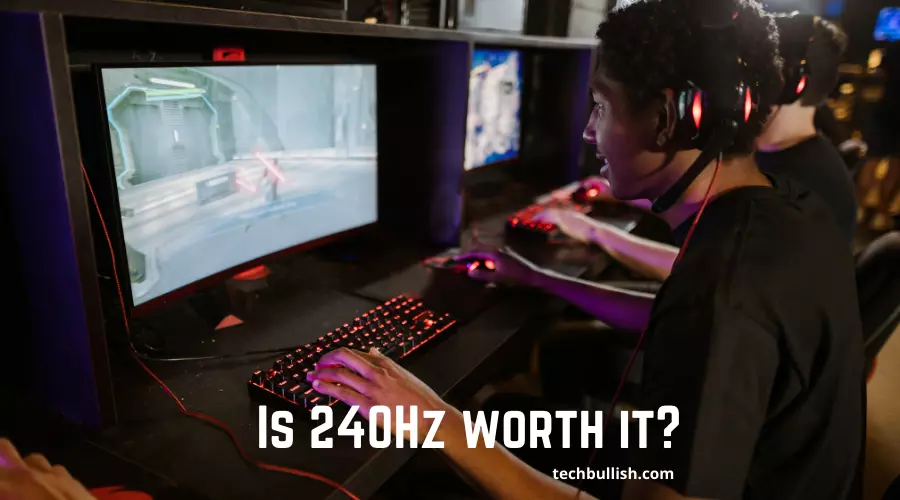Until recently, a refresh rate of 60Hz was considered the standard for top-of-the-line monitors.
However, the evolving monitor technology and the need for having higher quality monitors for gaming specifically for competitive gaming has increased the requirement of having a higher refresh rate in gaming monitors.
Monitors with a refresh rate of 240Hz provide us with smoother, cleaner, longer-lasting images among the greatest technological advancements in screens today!
This blog will look into if 240Hz is worth it.

Let’s get started!
Is 240hz worth it?
240hz televisions are definitely worth the money if you like games or watching sports. The difference between a 120hz and 240hz television is very noticeable and for anyone looking for the best possible gaming experience, a 240hz TV is a must.
So what should you be looking for in a 240hz refresh rate television?
When buying any TV, you want to make sure it has 1080p resolution; otherwise, you will notice that your picture isn’t as crisp.
However, to get the best 240hz experience possible, you need to pay close attention to response time and motion blur.
Recommendations indicate that if your game involves fast-moving images that jump from black/dark colors to white or light colors, it may benefit you to look at TVs with one millisecond response times, or advanced overdrive technology helps reduce ghosting.
What is 240Hz in Monitor?
Refresh rate is the number of times per second that a display updates the picture. The refresh rate is usually expressed as hertz (Hz).
A monitor with a 240Hz refresh rate can display 240 distinct frames per second, four times the number of frames a standard monitor of 60FPS can display.
The higher frame rate means that the display can show more detail in moving objects and avoid blurring horizontal lines,
which is a common problem when displaying a lot of text.
There are several advantages of having a monitor with a 240Hz refresh rate. First, it eliminates motion blur.
The movement of your mouse and the fast-paced scrolling of a website will not leave any trails behind.
You will also appreciate the high-quality graphics of your games and movies since the high refresh rate removes the blurring of fast-moving scenes.
I believe you’ll love how it performs!
Why is 240hz worth of gaming?
240Hz monitors can be a good amount of investment for you. So, let’s check why 240 Hz gaming monitors are worth the money.
Here are the main reasons that make 240Hz worth for gaming:
Reduces Screen Tearing and Stuttering
If you are a serious gamer, you know that there is no better feeling than the one you get when you get to play on a high-end gaming monitor.
However, one of the biggest issues that can ruin your gaming experience is screen tearing.
If you’re not familiar with screen tearing, it’s a visual artifact that occurs when your graphics card and your monitor have different refresh rates.
With 240 Hz monitors, you get a higher frame rate which means less screen tearing and stuttering, providing a smoother gaming experience.
Better Image Quality for Gaming
Image quality comes in place while playing FPS gaming.
If you don’t have a good gaming monitor with a higher refresh rate, then you will miss the smoothness and richness of image quality you get by reducing image ghosting.
240hz monitors can produce more accurate images, resulting in a better gaming experience.
Fast Response Time
240Hz monitors have a fast response time which reduces input lag, providing a more responsive gaming experience.
Even with a 120Hz monitor, you will feel a faster response time, but with 240Hz, it gets to the next level.
A fast response time is crucial when it comes to gaming. The faster the screen responds to your actions, the faster you react.
For instance, if you are playing games with fast movement, a slower response time can mean the difference between living and dying.
In the same way, a fast response time can also mean the difference between you getting a headshot and being killed instead.
If you score a headshot on an enemy with a slower screen response time, you will beat him every time.
If you are in a game that requires a lot of precision, a fast response time is a must.
Sometimes, you can only see the enemy for a fraction of a second, so you need a monitor that can respond to your actions as quickly as possible.
Of course, response time is not the only thing that is important in a gaming monitor, but the faster it responds, the better the experience is.
Advanced Technologies like G-Sync
Many 240hz monitors come with G-Sync, which helps eliminate screen tearing and stuttering.
NVIDIA G-SYNC, AMD FreeSync, and other technologies like them are display technologies that attempt to solve the problem of screen tearing and stuttering.
The screen tearing occurs when the monitor tries to display frames at a refresh rate different from the frame rate sent to the monitor by the graphics card.
You’ll see a horizontal line that splits the screen when this happens, which is very distracting in games.
Stuttering is an even more serious issue. This occurs when the monitor’s refresh rate is not in sync with the frame rate being sent by the graphics card.
The monitor will display the same frame multiple times in a row, effectively resulting in a lower framerate. This is most noticeable in fast-paced games.
Faster and Better for Gaming
They tend to be faster when displaying motion graphics, making them perfect for fast-paced games.
240hz monitors are perfect for gaming in competitive eSports titles, where faster displays can give you an edge.
Can you tell the difference between 144Hz and 240Hz?
The short answer is that most people cannot tell the difference between 144Hz and 240Hz. However, some people can tell a minimal difference.
Most people cannot tell the difference between 144Hz and 240Hz because the human eye cannot see more than 60 frames per second.
It means that the human eye will not see anything above 60fps.
However, in FPS games where you move frequently and require a High Frame rate, you will find the navigation and aiming easier, much quicker, and smoother on a 240Hz monitor.
Is 1080p or 1440p good for 240Hz?
When choosing the proper resolution for your 240Hz monitor, several things are to consider, but ultimately, it comes down to personal preference.
If you want the best gaming experience, 1080p is undoubtedly good for 240Hz but if you want the ultimate image quality and screen space, go with 1440p at 240Hz.
Is 240hz worth it over 144hz?
It depends on various factors, including their benefits, your budget, and the games you play.
The benefits of 240hz monitors
They offer a smoother gaming experience with less input lag than 144hz monitors because they can display more frames per second (240 versus 144), making them ideal for fast-paced games like first-person shooters and racing games.
The cost difference between 240hz and 144hz monitors.
A 240hz monitor will typically be more expensive than a 144hz monitor. So if you’re on a tight budget, you may want to stick with a 144hz monitor.
The games you play
If most of your games are not fast-paced, you may not experience a noticeable difference between 240hz and 144hz monitors.
However, if you play many fast-paced games, a 240hz monitor is worth considering.
Whether or not 240hz is worth it over 144hz depends on your individual needs and preferences.
Is 240Hz future-proof?
240Hz refresh rates are becoming more common on high-end gaming monitors.
There is no doubt that 240Hz monitors deliver gamers a smooth and responsive experience.
240Hz monitor Options
240Hz monitors are great for gaming, and there are very good quality 240Hz monitors available in the market.
Here are some of the awesome 240Hz monitors available at Amazon:
Last update on 2025-06-24 / Images from Amazon Product Advertising API
Conclusion
Let’s conclude the post on if a 240Hz monitor is worth it.
So, 240Hz is a big deal. It’s a huge step up from the standard 60Hz you’ve been used to for years.
However, it still isn’t as good as the first generation of 120Hz monitors.
The biggest question you’ll have to ask yourself is whether the increased flicker and cost are worth it for you.
If you’re a competitive gamer, you’ll want a 240Hz monitor, but for everyone else, 120Hz will probably be plenty.
I hope you enjoyed reading this post.

I’m Anirban Saha, Founder & Editor of TechBullish. With a B.Tech in Electronics and Communication Engineering, and 6+ years of experience as a software developer, I have expertise in electronics, software development, gadgets, and computer peripherals. I love sharing my knowledge through informational articles, how-to guides, and troubleshooting tips for Peripherals, Smart TVs, Streaming Solutions, and more here. Check Anirban’s Crunchbase Profile here.





